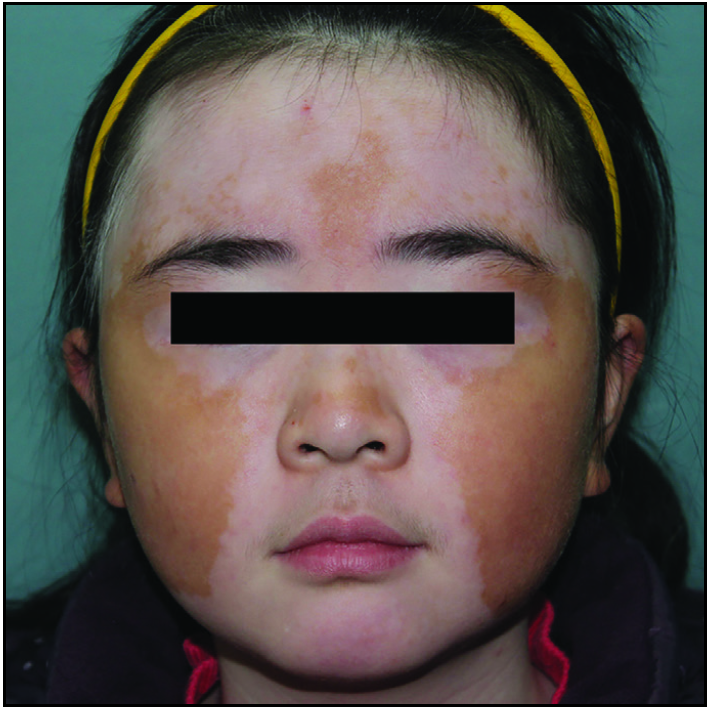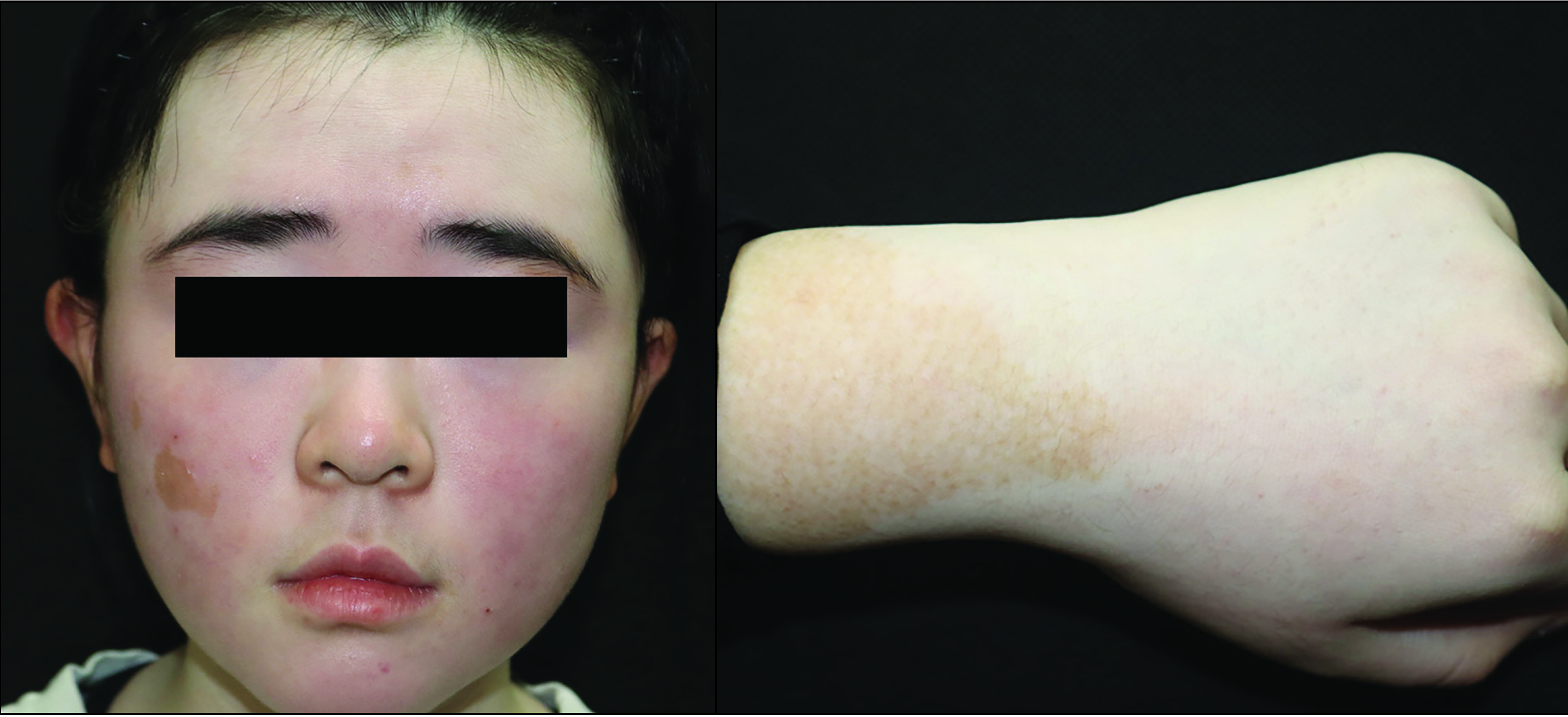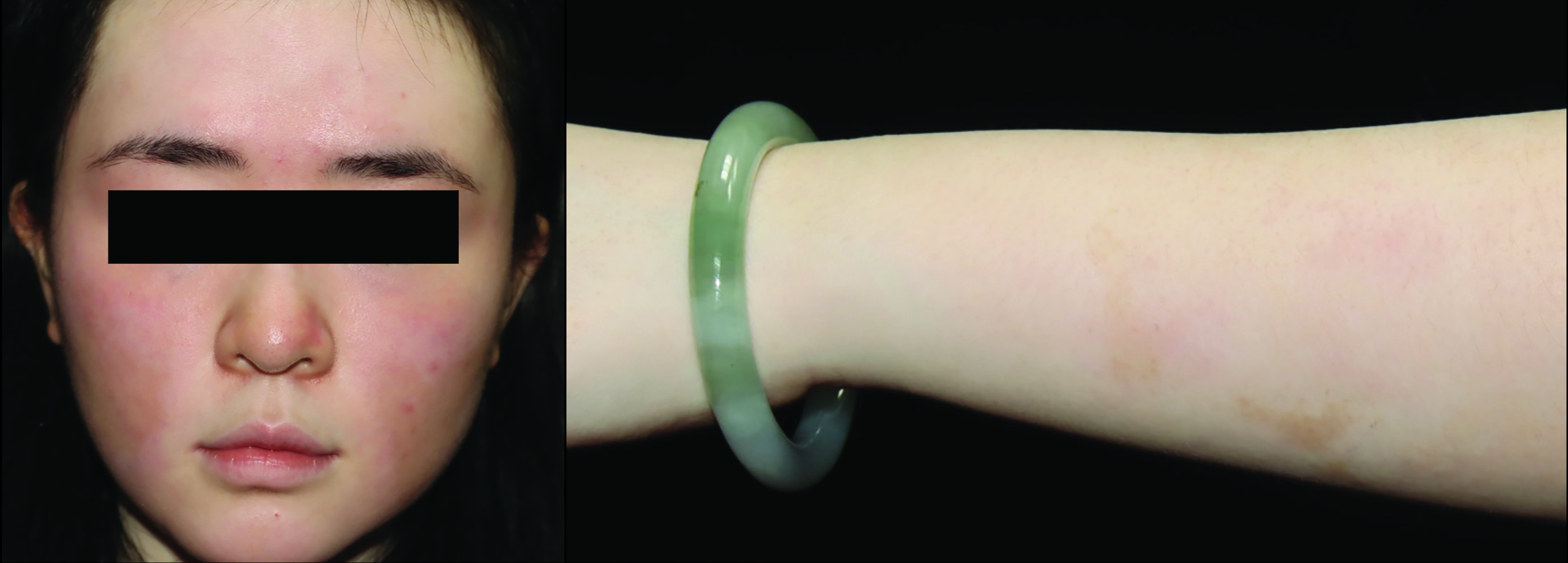Translate this page into:
Q-switched ruby laser for depigmentation: A feasible modality to treat vitiligo universalis in children
Corresponding author: Dr. Zhe Jian, Department of Dermatology, Xijing Hospital, Fourth Military Medical University, No 127 of West Changle Road, Xi’an, China. xjzhejian@fmmu.edu.cn
-
Received: ,
Accepted: ,
How to cite this article: Zhou Y, Gao T, Li C, Jian Z. Q-switched ruby laser for depigmentation: A feasible modality to treat vitiligo universalis in children. Indian J Dermatol Venereol Leprol. 2024;90:115-7. doi: 10.25259/IJDVL_36_2023
Dear Editor,
Vitiligo universalis is an extensive form (>60% to 90% of the body surface area) of non-segmental vitiligo (NSV) which is generally seen in adults.1 Depigmentation therapy targeting residual pigment is not a novel treatment anymore for vitiligo universalis in adults.2 However, there is still no consensus on whether depigmentation therapy could be safely used in paediatric patients with extensive vitiligo, who are unresponsive to common repigmentation strategy.2,3 Herein, we report an off-label use of the 694 nm Q-switched ruby (QSR) laser in an Asian child with vitiligo universalis for depigmentation.
An 11-year-old child with vitiligo visited our outpatient department in 2014. Her hypopigmentation started in the hip region when she was 4 years old. The Koebner phenomenon was negative and she had no family member with vitiligo or other autoimmune diseases according to her parents’. She received various treatments including topical/oral corticosteroids, calcineurin inhibitors and phototherapy in the past. However, the disease progressed rapidly in the next few years, resulting in approximately 90% of her body appearing depigmented, whereas some residual pigmentation remained on her forehead, both sides of the cheek, ear and forearm [Figures 1a and 1b]. Therefore, depigmentation therapy for the exposed areas (face and parts of limbs) was considered after discussion with her parents. In the meantime, the risk of repigmentation and a higher probability of a sunburn was also informed.

- Approximately 90% of the body was affected in an Asian child with universal vitiligo.

- Approximately 90% of the body was affected in an Asian child with universal vitiligo. Representative images of this child’s left forearm.
In many cases of adults with vitiligo, 694 nm QSR laser is a well-published treatment for depigmentation.2,4 It is also used to treat nevus of Ota in children safely.5 Thus, we decided on a trial with QSR laser (pulse duration of 20 nsec, 1.5 Hz frequency, 4-mm spot size and 4.5–6.0 J/cm2 energy). Topical 5% lidocaine cream was applied 1 hour prior to the laser session. Basic sun protection after therapy was emphasized. To avoid overtreatment, topical depigmenting agents were never prescribed throughout the management.
The timeline of management is demonstrated in Figure 2. She tolerated the first session without any adverse events. The depigmentation could be noticed in around 10 days when the scab was shed. She could not visit monthly because she lived in another city. Thus, we had further sessions at an interval of 6 months subsequently. During the treatment, we found her course of depigmentation was consistent with adults. Compared with the facial area, pigmentation on limbs was more resistant. After four sessions, we got a relatively optimal depigmentation outcome [Figures 3a and 3b]. So, we prolonged the interval of each session to once a year. Indeed, some pigmentation usually would relapse around a year after treatment, but it was not noticeable. Hereafter, she continued to visit our clinic once or twice a year to maintain the depigmentation. The last treatment was performed in 2022 and she was satisfied with the even complexion [Figures 3c and 3d].

- The timeline of management.

- Only small patchy residual pigmentation was left on the face and limb (left) after four sessions of the 694 nm QSR laser depigmentation therapy.

- The complexion of the face and limb (left) became even after nine sessions of the 694 nm QSR laser depigmentation therapy.
The Q-switched laser can destroy melanocytes with a larger safety range. In the process of building up the tolerance of children, we suggest that the 694 nm QSR laser can be the first step to start and the 755 nm Q-switched alexandrite (QSA) laser could be used as an alternative. We think the use of cryotherapy and topical agents for depigmentation like monobenzyl ether of hydroquinone (MBEH) are both not feasible in the paediatric age group, because of their higher risk of undesired side effects such as scar formation, skin irritation and contact dermatitis.2,4
In conclusion, depigmentation therapy with the 694 nm QSR laser can be added to the management of paediatric vitiligo universalis. However, future long-term prospective studies are needed to determine its efficacy and combination with other treatments.
Declaration of patient consent
The authors certify that they have obtained all appropriate patient consent.
Financial support and sponsorship
Nil.
Conflicts of interest
There are no conflicts of interest.
References
- A Practical Approach to the diagnosis and treatment of vitiligo in children. Pediatrics. 2016;138
- [Google Scholar]
- Depigmentation therapies in vitiligo. Indian J Dermatol Venereol Leprol. 2012;78:49-58.
- [CrossRef] [PubMed] [Google Scholar]
- Guidelines for the management of vitiligo: the European dermatology forum consensus. Br J Dermatol. 2013;168
- [Google Scholar]
- Successful and safe use of Q-switched lasers in the treatment of nevus of Ota in children with phototypes IV–VI. Laser Surg Med. 2018;50:56-60.
- [Google Scholar]






